MAMMALS
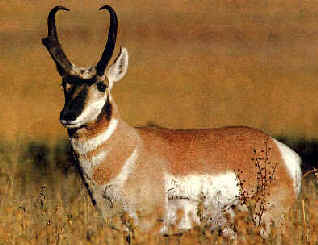
in Arizona
and in nearby New Mexico
Noting those during
Focus On Nature Tours
with an (*)
from
1993 thru 2015
during the months of January,
July,
August, and September
A cumulative list of Arizona Mammals compiled by Armas Hill
UPPER RIGHT PHOTO: a PRONGHORN,
the only antelope in the Americas
Codes:
CM:
occurs (or has occurred) in the area of the Chiricahua Mountains, in southeast
Arizona
GC: occurs (or has occurred) in the area of the Grand Canyon, in northern
Arizona
(ph): species with a photo in the FONT website
Links:
Upcoming
FONT Tour Itineraries for North America, including Arizona
A Bird-List & Photo Gallery of Arizona Birds, in 2
parts:
Part #1: Quails to Becards Part #2: Flycatchers to
Buntings
North
American Mammals (with some photos)
Arizona Amphibians &
Reptiles (with some photos)
Arizona
Butterflies, Dragonflies & Damselflies, and Grasshoppers (with some photos)
Plants of the Desert & Nearby Habitats (with some photos)

List of Mammals:
- Eastern Cottontail (*) (ph) ______
CM
Sylvilagus floridannus
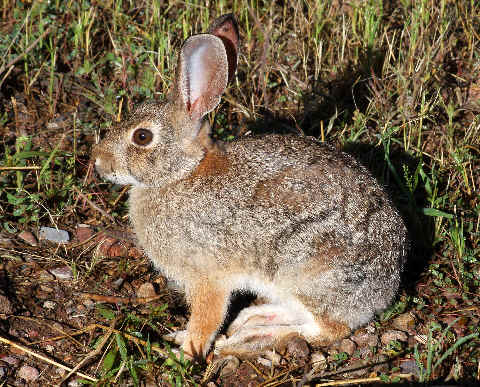
An Eastern Cottontail photographed during a
FONT tour in Arizona
(photo by Doris Potter)
- Desert Cottontail (*) (ph) ______
CM
GC
Sylvilagus audubonii
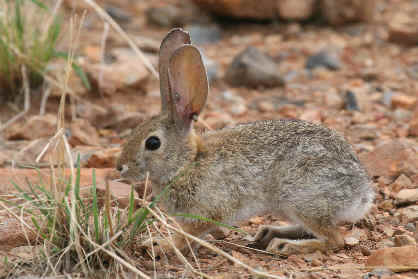
A Desert Cottontail photographed during a FONT tour in Arizona
- Mountain
(or Nuttall's) Cottontail
______ GC
Sylvilagus nuttallii
- Black-tailed Jackrabbit (*) (ph) ______
CM
GC
Lepus californicus
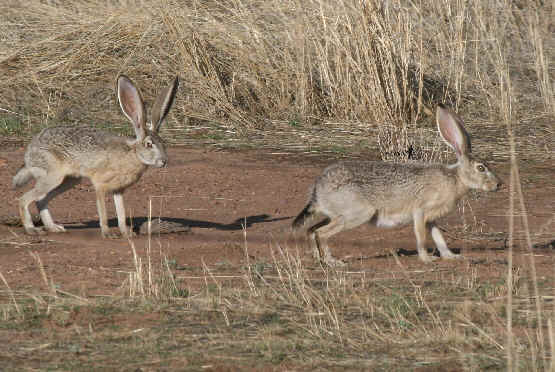
Black-tailed Jackrabbits photographed during a FONT Arizona tour
- Antelope Jackrabbit (*) (ph) ______
CM
Lepus alleni
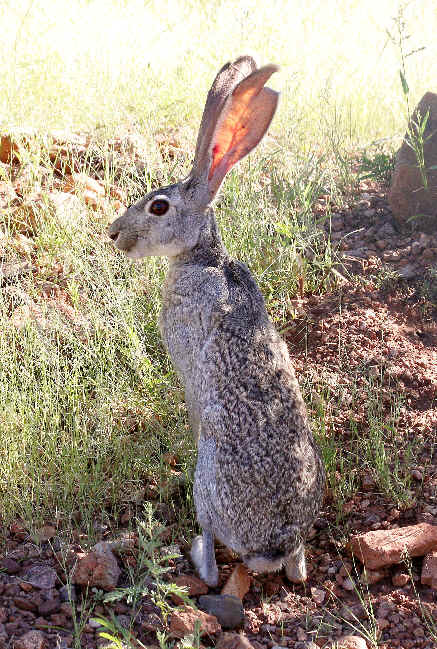
An Antelope Jackrabbit photographed during a FONT Arizona/Mexico Tour
(photo by Doris Potter)
- Least Chipmunk (*) ______
GC
Tamias minimus
- Uinta Chipmunk (*) ______
GC
Tamias umbrinus
- Cliff Chipmunk (*) (ph) ______
CM
GC
Tamias dorsalis
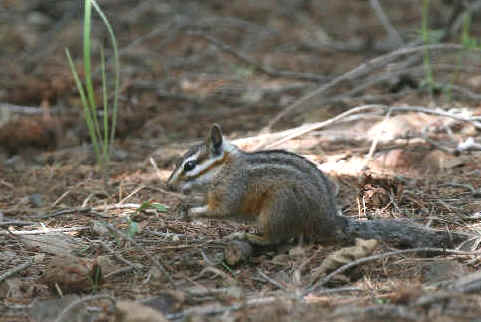
A Cliff Chipmunk photographed during a FONT Arizona tour
- Variegated Ground Squirrel (has been
called Rock Squirrel) (*) (ph) ______
CM GC
Spermophilus variegatus
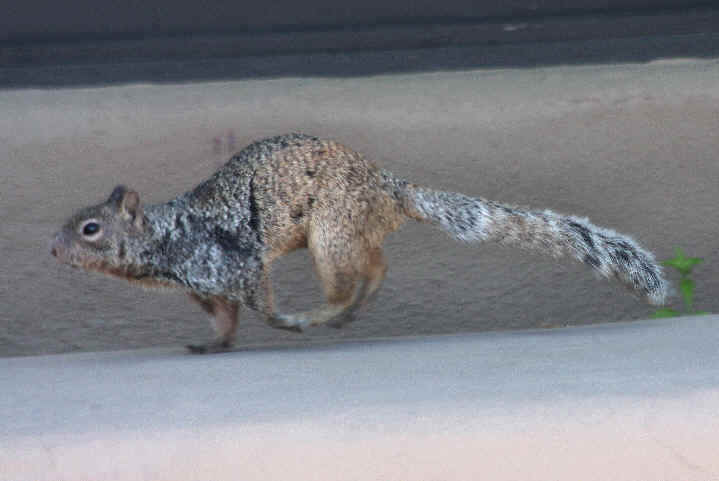
A Variegated Ground Squirrel (or Rock Squirrel)
photographed
during a FONT tour in Arizona in 2008
(photo by Doris Potter)
- Round-tailed Ground Squirrel
(*) (ph) ______
Spermophilus tereticaudus
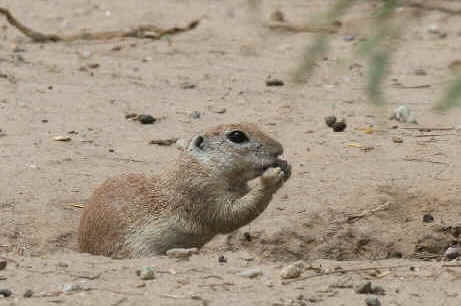
A Round-tailed Ground Squirrel photographed during a FONT Arizona tour
- Spotted Ground Squirrel ______ CM
GC
Spermophilus spilosoma
- Golden-mantled Ground Squirrel ______
GC
Spermophilus lateralis
- Harris's (or Yuma) Antelope Squirrel
(*) (ph) ______ CM GC
Ammospermophilus harrisii
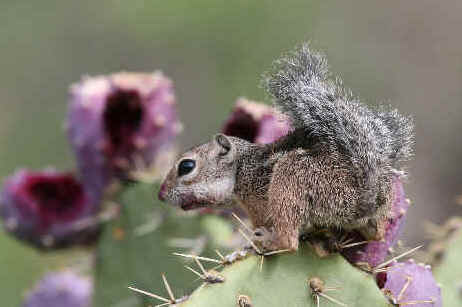
A Harris' Antelope Squirrel photographed during a FONT Arizona tour
- White-tailed Antelope Squirrel
(*) ______ GC
Ammospermophilus leucurus
- Gunnison's Prairie Dog (*) (ph)
______ GC
Cynomys gunnisoni
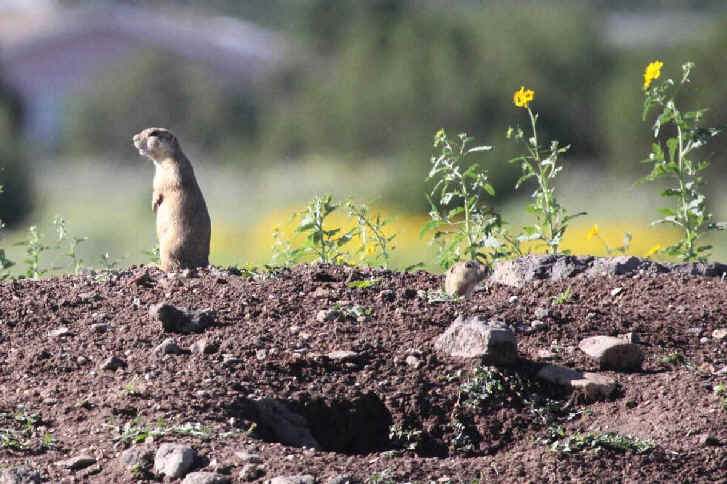
A Gunnison's Prairie Dog during the FONT Arizona
tour in August 2010
in the area of the Grand Canyon
(photo by Marie Gardner)
- Black-tailed Prairie Dog ______
CM
Cynomys ludovicianus
The Black-tailed Prairie Dog has been locally extirpated in southeast Arizona since 1941.
- Arizona Gray Squirrel (*) ______
Sciurus arizonensis
- Tassel-eared (or Abert's) Squirrel
(*) ______ GC
Sciurus aberti
- Kaibab Squirrel ______ GC
Sciurus aberti kaibabensis
- Mexican Fox Squirrel (*) ______
CM (another name is Apache Fox Squirrel, Sciurus apache)
Sciurus nayaritensis
In the US, the Mexican Fox Squirrel is endemic in the Chiricahua Mountains.
- Red Squirrel ______ GC
Tamiasciurus hudsonicus
- Botta's Pocket Gopher ______ GC
(has been called Common Pocket Gopher,
or Valley Pocket Gopher)
Thomomys bottae
- Northern Pocket Gopher ______
GC
Thomomys talpoides
- Southern Pocket Gopher ______ CM
Thomomys umbrinus
- Silky Pocket Mouse ______
CM GC
Perognathus flavus
- Arizona Pocket Mouse ______ GC
Perognathus amplus
- Great Basin Pocket Mouse ______
GC
Perognathus parvus
- Long-tailed Pocket Mouse ______
GC
Chartodipus formosus
- Rock Pocket Mouse ______
CM GC
Chaetodipus intermedius
- Desert Pocket Mouse ______ CM GC
Chaetodipus penicillatus
- Bailey's Pocket Mouse (*)
______ CM
Chaetodipus baileyi
- Hispid Pocket Mouse ______ CM
Chaetodipus hispidus
- Merriam's Kangaroo Rat ______
CM
GC
Dipodomys merriami
- Ord's Kangaroo Rat ______ CM GC
Dipodomys ordii
- Chisel-toothed Kangaroo Rat ______
GC
Dipodomys microps
- Banner-tailed Kangaroo Rat
______ CM
Dipodomys spectabilis
- American Beaver (ph) ______
GC
Castor canadensis
- Western Harvest Mouse ______ CM GC
Reithrodontomys megalotis
- Plains Harvest Mouse ______ CM
Reithrodontomys montanus
- Fulvous Harvest Mouse ______
CM
Reithrodontomys fulvescens
- White-footed Deer Mouse ______
CM
Peromyscys leucopus
- Merriam's Deer Mouse ______ CM
Peromyscus merriami
- Canyon Deer Mouse ______ GC
Peromyscys crinitus
- Cactus Deer Mouse ______ CM GC
Peromyscys eremicus
- North American Deer Mouse (*)
______ CM GC
Peromyscys maniculatus
- Brush Deer Mouse ______ CM GC
Peromyscys boylii
- Pinon Deer Mouse ______ CM GC
Peromyscys truei
- Northern Rock Deer Mouse ______
CM
Peromyscys nasutus
- Northern Pygmy Mouse ______ CM
Baiomys taylori
- Northern Grasshopper Mouse ______
GC
Onychomys leucogaster
- Southern Grasshopper Mouse
______ CM
Onychomys torridus
- Hispid Cotton Rat ______ CM
Sigmodon hispidus
- Tawny-bellied Cotton Rat ______
CM
Sigmodon fulviventer
- Yellow-nosed Cotton Rat ______ CM
Sigmodon ochrognathus
- White-throated Woodrat (*) ______
CM
GC
Neotoma albigula
- Desert Woodrat ______ GC
Neotoma lepida
- Stephen's Woodrat ______ GC
Neotoma stephensi
- Mexican Woodrat ______ CM GC
Neotoma mexicana
- Bushy-tailed Woodrat ______ GC
Neotoma cinerea
- House Mouse (NAi) ______ GC
Mus musculus
- Long-tailed Vole ______ GC
Microtis longicaudus
- Mogollon
(or Mexican) Vole ______
GC
Microtus mogollonensis
(or mexicanus)
Microtus mogollonensis
(or mexicanus) hualapaiensis
_____
GC
(an endangered subspecies, "Hualapai Vole")
- Muskrat (ph) ______ GC
Ondatra zibethicus
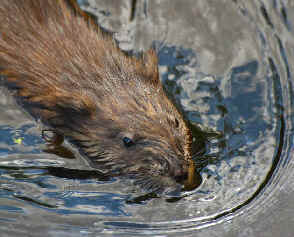
Muskrat
(photo by Doris Potter)
- North American Porcupine (ph) ______
CM
GC
Erethizon dorsatum
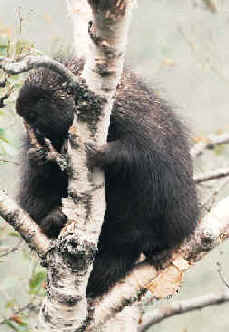
North American Porcupine
(photo by Doris Potter)
- Red Fox (ph) ______ GC
Vulpes vulpes
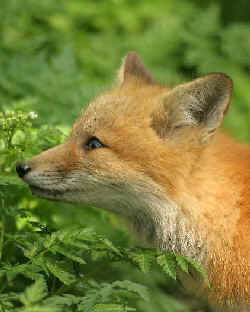
Red Fox
(photo by Doris Potter)
- Kit Fox ______ CM GC
Vulpes macrotis
- Gray Fox (*) ______ CM GC
Urocyon cinereoargenteus
- Coyote (*) (ph) ______ CM GC
Canis latrans
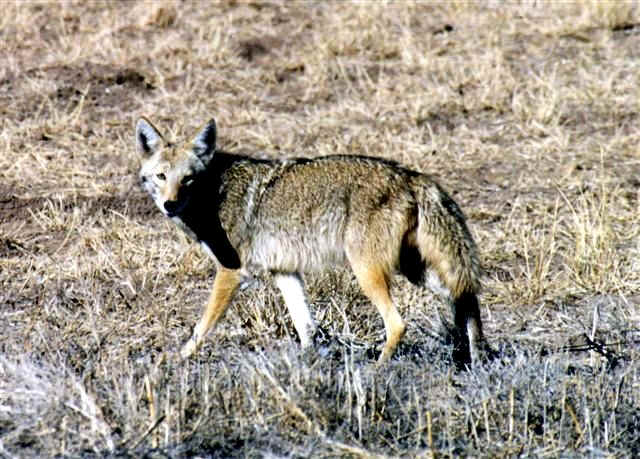
Coyote
- Mexican Gray Wolf ______ CM
Canis lupus baileyi
Called "El Lobo", the Mexican Gray Wolf is the
smallest subspecies of the North American gray wolves. It was last recorded in the Chiricahua Mountains in 1971.
After it was extirpated in the southwest US, 34 were returned to southeast
Arizona in a reintroduction program in 1998. The goal of that program was to
restore at least 100 wolves to the wild by 2008. Unfortunately, by the end
of that year, there were only approximately 50. Only about 200 Mexican
Wolves are in captivity.
Mexican Wolves ranged from central Mexico to southwest Texas,
southern New Mexico, and southeast Arizona. The reintroduction was into the
Apache National Forest in southeast Arizona.
- Black Bear (*) ______ CM GC
Ursus americanus
- "Mexican" Grizzly Bear
______ CM
Ursus arctos nelsoni
The "Mexican" Grizzly Bear has been extinct in the Chiricahua Mountains since 1901. The
subspecies was last seen anywhere in 1964, in the Mexican state of
Chihuahua, and so has been presumed extinct for about 50 years.
- Ringtail ______ CM GC
Bassariscus astutus
- Northern Raccoon (ph) ______
CM GC
Procyon lotor
- White-nosed Coati (*) (ph) ______
CM
Nasua narica
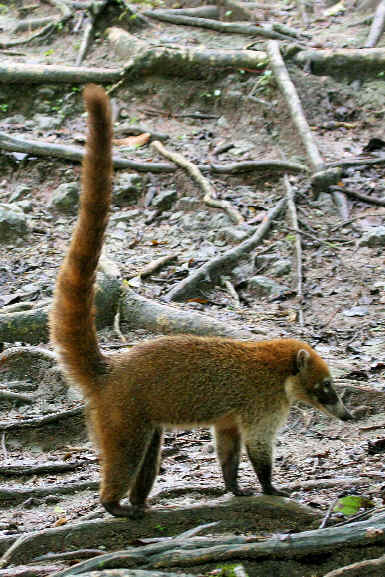
A White-nosed Coati photographed during a FONT tour
- Ermine ______ GC
Mustela erminea
- Long-tailed Weasel ______ GC
Mustela nivalis
- Black-footed Ferret ______ GC
Mustela nigripes
- American Badger (ph) ______
CM GC
Taxidea taxus
- Hooded Skunk (*) ______
CM
Mephitis macroura
- Striped Skunk (*) ______ CM GC
Mephitis mephitis
- Western Spotted Skunk (*) ______
CM GC
Spilogale gracilis
- Western Hog-nosed Skunk ______
CM
Conepatus mesoleucus
- Northern River Otter ______ GC
Lontra canadensis
- Bobcat (*) (ph) ______ CM GC
Felis
(formerly Lynx) rufer
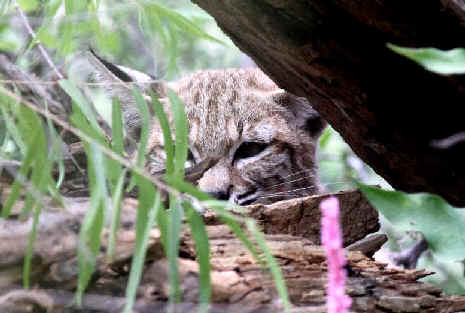
A Bobcat seen during the FONT tour in southern
Arizona in August 2010
as it was resting during the day.
(photo by Marie Gardner)
- Ocelet (ph) ______ CM
Felis
(formerly Leopardus) pardalis
- Jaguarundi ______ CM
Felis
(formerly Herpailurus) yagouaroundi
- Puma (or Mountain Lion, or
Cougar) ______ CM GC
Felis
(formerly Puma) concolor
- Jaguar (ph) ______ CM
Panthera
(formerly Jaguarius) onca
The Jaguar was not recorded in southern Arizona from 1938 until 1987, when 1 was killed in
the Dos Cabezas Mountains. Another was photographed in the Peloncillo
Mountains in 1996.
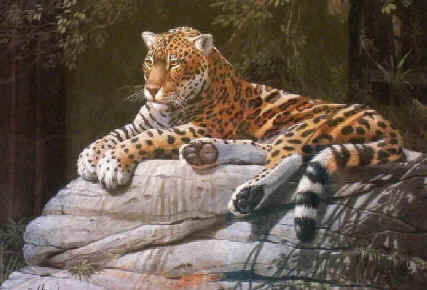
A Painting of a Jaguar by a person in southern
Arizona, Bonnie Swarbrick
- Merriam's Shrew ______ GC
Sorex merriami
- Dwarf Shrew ______ CM GC
Sorex nanus
- Desert
(or Gray) Shrew ______ GC
Notiosorex crawfordi
- Arizona Shrew ______ CM
Sorex arizonae
- Vagrant Shrew ______ CM
Sorex vagrans
- California Leaf-nosed Bat
______ CM
Macrotus californicus
- North American Long-nosed Bat
(*) (ph) ______ CM
Leptonycteris yerbabuenae
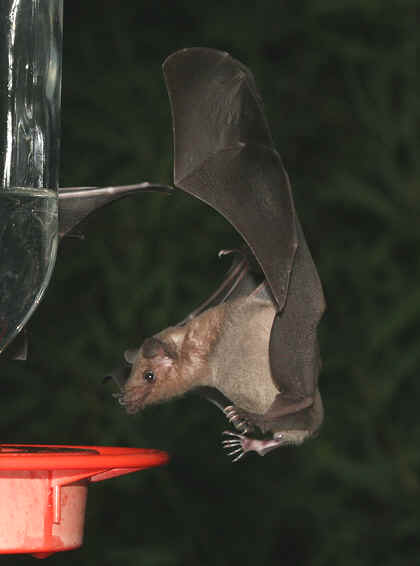
North American Long-nosed Bat
- Mexican Long-nosed Bat (*) ______
GC
Leptonycteris nivalis
- Mexican Long-tongued Bat ______
CM
Choeronycteris mexicana
- Little Brown Bat (Myotis)
______ CM
Myotis lucifugus
- Yuma Myotis ______ CM GC
Myotis yumanensis
- Long-eared Myotis ______ GC
Myotis evotis
- Fringed Myotis ______ CM GC
Myotis thysanodes
- Long-legged Myotis ______ CM GC
Myotis volans
- California Myotis ______ CM GC
Myotis californicus
- Cave Myotis ______ CM
Myotis velifer
- Western Small-footed Myotis ______
CM
GC
Myotis ciliolabrum
- Southwestern Myotis ______ CM
Myotis auriculus
- Silver-haired Bat ______ CM GC
Lasionvcteris noctivagans
- Western Pipistrelle ______ CM GC
Pipistrellus hesperus
- Big Brown Bat ______ CM GC
Eptesicus fuscus
- Western Red Bat ______ CM GC
Lasiurus blossevillii
- Hoary Bat ______ CM GC
Lasiurus cinereus
- Western Yellow Bat ______
CM (was part of the
Southern Yellow Bat)
Lasiurus xanthinus
- Spotted Bat ______ CM GC
Euderma maculatum
- Townsend's Big-eared Bat ______
GC
Corynoribinus townsendii
- Allen's (Mexican) Big-eared Bat
______ CM GC
Idionycteris phyllotis
- Pallid Bat ______ CM GC
Antrozous pallidus
- Mexican
(or Brazilian) Free-tailed
Bat ______ CM GC
Tadarida brasiliensis
- Big Free-tailed Bat ______ CM GC
Nyctinomops macrotis
- Pocketed Free-tailed Bat ______
CM
Nyctinomops femorosaccus
- Western Mastiff Bat
______ CM GC (also
called Greater Bonneted Bat)
Eumops perotis
- Underwood's Bonneted Bat ______
Eumpos underwoodi
In the US, the Underwood's Bonneted Bat is known only in extreme
southern Arizona, where they can be found drinking at desert
pools.
- Collared Peccary (or Javelina) (*) ______
CM GC
Tayassu tajacu (was at one
time Pecari angulatus)
- Elk (ph) ______ CM
GC
Cervus elaphus
The "Merriam's Elk" has been extinct in the Chiricahua Mountains
since 1906.
- "Rocky Mountains" Mule Deer (*)
(ph) ______ CM GC
Odocoileus hemionus
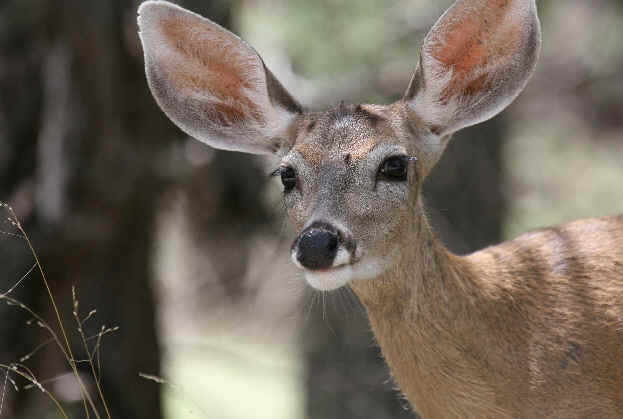
A Mule Deer, with its large ears,
photographed during a FONT tour in Arizona
- "Coue's" White-tailed Deer
(*) (ph) ______ CM
Odocoileus virginianus
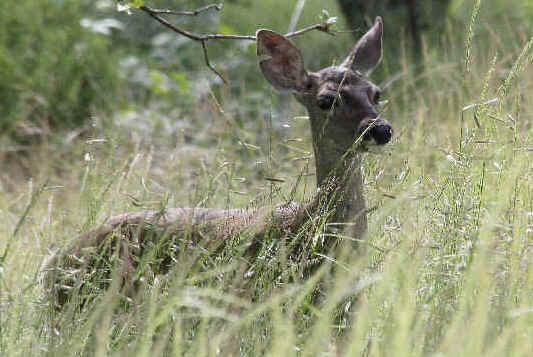
A Coue's White-tailed Deer photographed during
a FONT tour in Arizona in 2008
(photo by Doris Potter)
- Pronghorn (*) (ph) ______
CM GC
Antilocapra americana
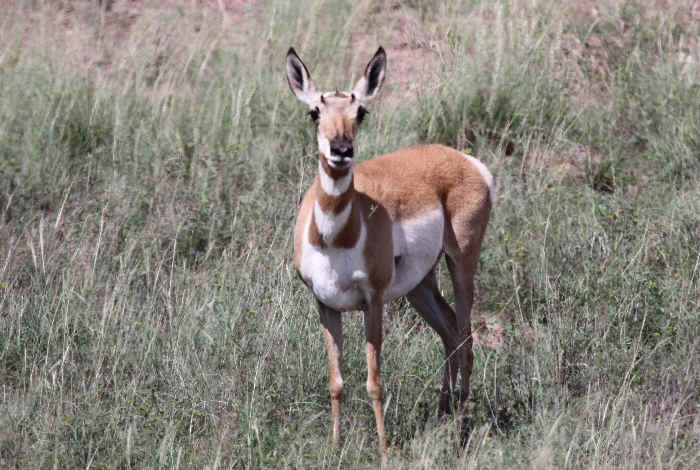
A Pronghorn during the FONT Arizona tour in August
2010
in the area of the Painted Desert/Petrified Forest National Park.
(photo by Marie Gardner)
- Desert
(or Mountain) Bighorn Sheep
(ph)
______ CM GC
Ovis canadensis
Locally extinct in the Chiricahua Mountains since 1885.
One of the references for this mammal list is the book:
"Mammals of North America" by Roland W. Kays & Don E. Wilson,
published by Princeton Univ Press, 2002.
Also "The Encyclopedia of Mammals", edited by Dr. David
Macdonald, updated in 2006.
To
Top of Page






















